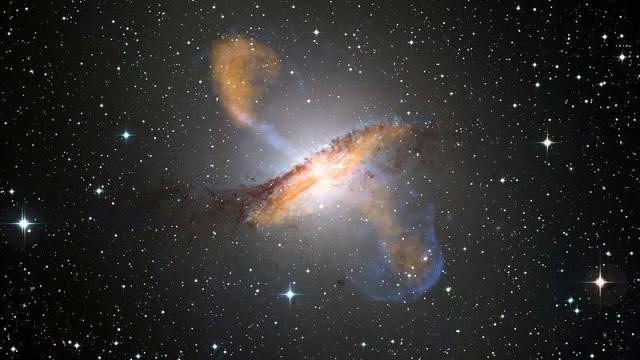A new study is shedding light on the way galaxies interact with the incredibly massive black holes at their centres.
Astronomers think every galaxy has an incredibly dense region at its centre called a supermassive black hole. Many of these black holes, called active galactic nuclei (AGNs) spew jets of radiation. But lots of questions remain about the relationship between AGNs and the galaxies that surround them, like, does black hole growth correspond to star formation rate, or simply to the mass of the galaxy? Computer simulations are revealing the true nature of this complex connection.
“They seem to control and regulate each other,” Priyamvada Natarajan, study author and professor in physics and astrophysics at Yale University, told Gizmodo.
The researchers ran complex computer simulations called ROMULUS25 and ROMULUSC, which model the behaviour of galaxies from the Big Bang to today. The simulations include the black holes at the gassy centres of galaxies as well as stars forming from the gas. The results: black holes and their galactic hosts grow together, and the rate at which stars form is directly related to the rate at which black holes eat.
These findings paint a kind of dance between black holes and the galaxies that host them, where the rate at which black holes eat and the rate at which stars form regulate one another, Natarajan said. She was excited because the study provides more context for correlations that have previously been found in real observational data.
Perhaps surprisingly, the study found that the mass of the galaxy and the overall environment the black hole is in don’t really affect the black hole, according to the paper published in the Monthly Notices of the Royal Astronomical Society. Neither did galactic mergers, which goes against what many scientists think, Kastytis Zubovas, researcher at the Centre for Physical Sciences and Technology who was not involved in the study, told Gizmodo in an email. He thought the paper is a “very thorough investigation of how galaxies co-evolve with their central supermassive black holes.”
But of course, this is just a simulation, and simulations require concessions. Zubovas pointed out that the main results include averages over 300-million-year timescales, which means that shorter-term processes (as well as smaller-scale processes) may be missing from the picture. The scientists hope to perform further simulations that explore the specifics of this relationship.
Computer simulations of galaxies might not feel like the most dramatic of science, but they’re an important way for humans to understand processes that occur on timescales far longer than our lifespans. And these are crucial calculations for understanding our universe and the way that structures form and evolve inside of it. And given their ferocity, it’s nice to find evidence that black holes are more than just central vacuum cleaners—they also seem to be important to the development of stars themselves.
